
Title aside, no projectiles are completely reliable at getting through brush and to a target. We used to think the answer was blunt-nosed, heavy-for-caliber, slow-moving bullets—but the reality is that anything can happen if you put a barricade of stalks and stems in front of a target. Often, you can get away with a bit of grass or a leafy screen, especially if it’s close to the target. But back the obstruction off several feet and most bullets—blunt-nose or spitzer—will skew off course, often tumbling.
So, if “brush-busting” cartridges don’t get through brush much better than anything else, what good are they? Here are a few thoughts: They hit game hard and deliver high-energy payloads. I’ve gotten many letters and emails from hunters who want their deer down on the spot. Often, they hunt smaller properties or hard-hunted public land, so they need to be able to anchor their game. The new, old and resurrected brush-busters can do this. My sense is these cartridges are coming back, along with renewed interest in the all-American lever-action. Effective, yes, but limited in range.
Range & Velocity
In some circles, this is anathema. Long-range shooting is “in.” More accurate rifles, better optics, flatter-flying bullets and all manner of devices make it easier than ever to figure the shooting solution. I’m not against this; in open country, with the right equipment, my range envelope has expanded—but I don’t need range all the time. Of our two dozen Kansas deer stands, only one offers a possible 300-yard shot. The rest average less than 100. I’m lucky; I don’t have to worry about a buck crossing a fence line or being tagged by a stranger. However, in our thick forest, I’d rather not have a long tracking job at dusk. I like my deer to be down.
Despite the current rage for range, many hunters don’t need the capability. Whitetail hunters often use the same familiar stands year after year, relying on known shooting distances. In thick stuff continent-wide, and for a variety of game, vegetation and terrain dictate closer shots. Millions of American hunters, by local law, must use shotguns for deer. Although better than ever, shotguns and slugs are still short-range tools. Shotgun hunters site their stands and plan their strategies knowing their range limitations, as do bowhunters. The traditional intent of the shotgun-only rule is to increase safety by limiting range.
Shotgun-toting deer hunters bear some responsibility for the revival of the brush-busters. Five states now allow certain centerfire rifle cartridges (in lieu of shotguns) for big game in some areas and seasons. All have in common the overpopulation of whitetails, increasing road hazards and lots of small farms and villages. The idea was to increase hunting efficiency, and thus harvest, without increasing hazard. Criteria vary by state, including case length, caliber and performance limitations. We lump them together as “straight-wall” cartridges because straight (rather than bottlenecked) case design limits case capacity—and thus velocity and range—which is the goal.
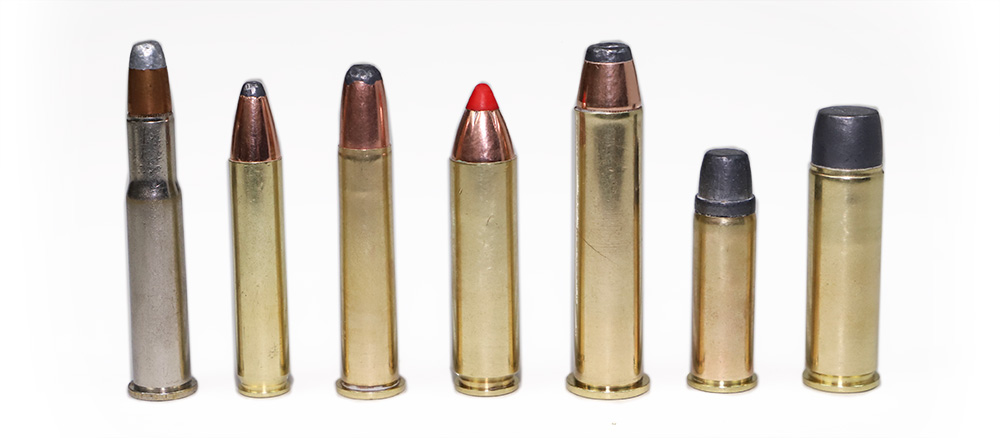
Several great close-cover cartridges are currently available, including (l. to r.): .30-30 Win.; the newer “straight-wall” 350 Legend, 360 Buckhammer and .450 Bushmaster; the venerable .45-70 Gov’t; and the revolver chamberings .44 Mag. and .500 S&W Mag., which generate even more energy through a longer carbine barrel.
Certain older brush-busters were “grandfathered” in, coincidentally meeting the criteria, but most do not. However, recent brush-busters were carefully designed to meet all criteria. Whether straight-wall-legal or not, classic brush-busters have one thing in common: They are slow. Many hover around 2,000 f.p.s., or just above blackpowder velocity. The fastest we might consider in the group run to 2,500 f.p.s. Hardly tortoises, but not in the same league with fast magnums. Not ideal for long range, not well-suited to big, open country—the brush-busters are for those of us who hunt brush, timber and swamp, where visibility limits shot distances.
Hitting Power
I was a child of the first magnum craze (late 1950s and ’60s), worshipping at the shrine of velocity. Also, I grew up a Western hunter, comfortable in open country with no knowledge of close-cover hunting. Heck, I was nearly 40 before I took a deer with a .30-30 Win. Our brush-busters can’t plow through brush, but there is truth in their hard-hitting reputation. It took me years to properly appreciate this.
In deriving kinetic energy, expressed in foot-pounds (ft.-lbs.), velocity is squared. Bullet weight is not, so energy increases exponentially with velocity. Foot-pounds are our most common yardstick for cartridge comparison, so fast cartridges tend to win ballistic chart comparisons—bullet diameter usually doesn’t enter into the equation. But the older I get, the more convinced I am: In performance on game, both bullet weight and frontal area matter. Larger-diameter bullets create larger wound channels and transfer more energy upon impact, dealing a heavier blow. Bullet construction matters greatly, but heavier bullets tend to penetrate more deeply.
So, I’m convinced that the brush-busters, especially those of greater than .30 caliber, are more effective for close-cover hunting. Not because they bust brush, but because their larger-diameter (and often heavier) bullets hit harder and anchor game better.
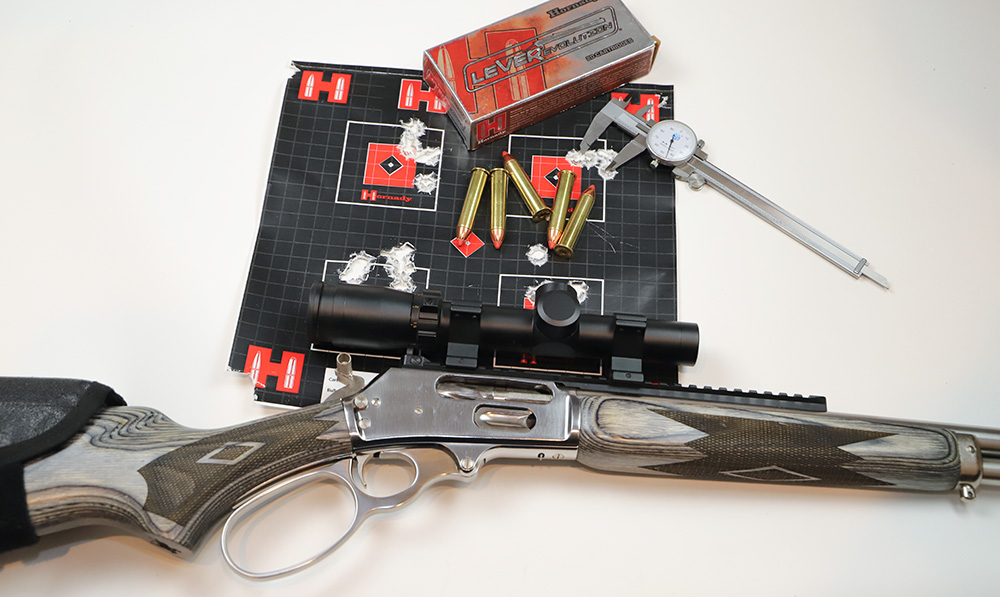
The brush-busters aren’t famous for extreme accuracy, but it depends on the rifle. This Ruger-made Marlin 1895 SBL is one of the most accurate .45-70 lever-actions the author has ever fired.
Most traditional brush-busters were born in tubular-magazine rifles. Until Hornady’s Flex-Tip eXpanding (FTX) bullet came along in 2007, all tubular magazines were limited to blunt-nosed bullets (to preclude detonation in the magazine). Such shapes mean that their aerodynamics are relatively terrible, with velocity and energy dropping quickly—reducing effective range and downrange performance. But there’s another factor our granddads knew: As in larger calibers, blunt-nosed bullets transfer more energy on impact than spitzers, dealing a heavier initial blow. With some cartridges, we have choices between flat-nose and round-nose bullets. For sheer down-right-there impact, the blunter the better. To wring out every yard you can, Hornady’s FTX and Mono-Flex spitzers, safe in tubular magazines, flatten trajectories and carry more energy farther downrange. But, on the other hand, if your hunting is up close and personal and you want maximum impact, give up a few yards of effective range and go old-school with traditional blunt-nosed bullets. Over time and with experience, you will see the difference.
New Kids On The Block
The .450 Bushmaster pre-dated straight-wall legislation but, with its short case, met all the criteria anyway. Recent cartridge developments have been designed to meet the legal restrictions: 350 Legend, 360 Buckhammer and now 400 Legend. I’ve heard some curmudgeonly grousing about why the industry has allowed straight-wall legislation to dictate cartridge design. Why not just bring back old hard-hitters like .35 Remington and .444 Marlin?
Like it or not, our industry is driven by new stuff. New stuff creates buzz; old stuff is old news. It doesn’t always make sense to me, either. Currently, the five straight-wall states are: Illinois, Indiana, Iowa, Michigan and Ohio. All five are important deer-hunting states. Michigan was early to the straight-wall party; Michigan hunters alone bought enough .450 Bushmaster rifles and ammo to make the entire industry take notice.
Most older cartridges have problems on two counts. First, few fit all the straight-wall criteria, which, again, vary by state. Second, whether because of rim or length, almost no older cartridges are AR-compatible, and manufacturers cannot ignore the popularity of the AR platform. The Bushmaster was conceived as a specialized military cartridge. Originally available only in ARs, Ruger saw amazing demand when it chambered it in the American Rifle. So, let’s look briefly at it and our three brand-new brush-busters, the two Legends and the Buckhammer.
Because of AR action limits, the .450 Bushmaster cannot use bullets as heavy as the .45-70 Gov’t. Part of the .45-70’s resurgence is based on the “guide gun” concept: defense, primary or backup, for big bears. With its lighter-for-caliber bullets, the .450 Bushmaster doesn’t play in this game. However, in the larger universes of deer, hog and black bear hunting, the Bushmaster is similar in performance to the .45-70, which is not damning it with faint praise; it is a hard-hitting and effective cartridge. I’ve used it for hogs and black bear; its big .45-cal. bullet makes a difference. Unfortunately, it also kicks like a .45-70—too much of a good thing for most youngsters and small-statured shooters.
To no small extent, this is why Winchester developed the 350 Legend. Introduced in 2019 in both ARs and bolt-actions, and now S&W’s big X-Frame revolver, the 350 Legend meets all straight-wall criteria and offers solid 200-yard performance on deer with wonderfully mild recoil and report. I have used it on whitetails, hogs and black bear. It’s a great deer cartridge, but, I’ll be honest, in my experience, it’s minimal for big hogs and black bears. In factory loads, bullets are light (and sharp-pointed), in part to maintain AR capability and to keep trajectory as flat as possible, maximizing effective range.

S&W’s big X-Frame revolvers are now available chambered in 350 Legend, but rifle cartridges lose velocity and energy through a shorter barrel. Conversely, various handgun cartridges are chambered in rifles and carbines, resulting in significant velocity gains.
Enter its big younger brother, Winchester’s 400 Legend. The first 400 Legend load uses a 215-grain bullet traveling at 2,250 f.p.s.—which is light for its caliber and short to enable AR compatibility. However, it has greater frontal area, higher velocity and produces more energy than the 350 Legend, yet without teeth-jarring recoil. It will thump deer and offers a good option for hunters who also hunt hogs and black bears.
Unveiled at SHOT Show in 2022, Remington Ammunition’s 360 Buckhammer is old-school. It uses a rimmed case with a traditional 0.358" rifle bullet. In fact, it is so retro that it was introduced in Henry’s traditional tubular-magazine lever-action rifle. So why not just bring back the .35 Remington? Must I repeat myself? Buckhammer fits all straight-wall criteria in all states—the old .35 Rem. does not. Performance-wise, it is so similar to .35 Remington that initial loadings used the same Core-Lokts that gave the .35 Rem. its reputation. It is not dramatically more powerful than the 350 Legend, but it offers more velocity and energy with a heavier bullet. And, at close range, its traditional round-nose bullet is an advantage. I was able to use one of the first for both hogs and whitetails. It is not “better” than the .35 Rem., but it’s new, available and straight-wall legal.
Oldies But Goodies
The .45-70 Gov’t was almost gone when I was a kid. In 1967, Bill Ruger did a run of No. 1 single-shots in .45-70, the first new .45-70 since the 1930s. Many thought Ruger was nuts, but look at the old war horse now, one of our most popular centerfires. In later Remington production of Marlin lever-actions, the company’s .45-70 Gov’ts significantly outsold its .30-30 rifles. So, naturally, the first Ruger-made Marlin was a .45-70. As I said, the short-barreled “guide gun,” with modern sights and trimmings, has done much to revive interest in lever-actions and the .45-70 Gov’t.
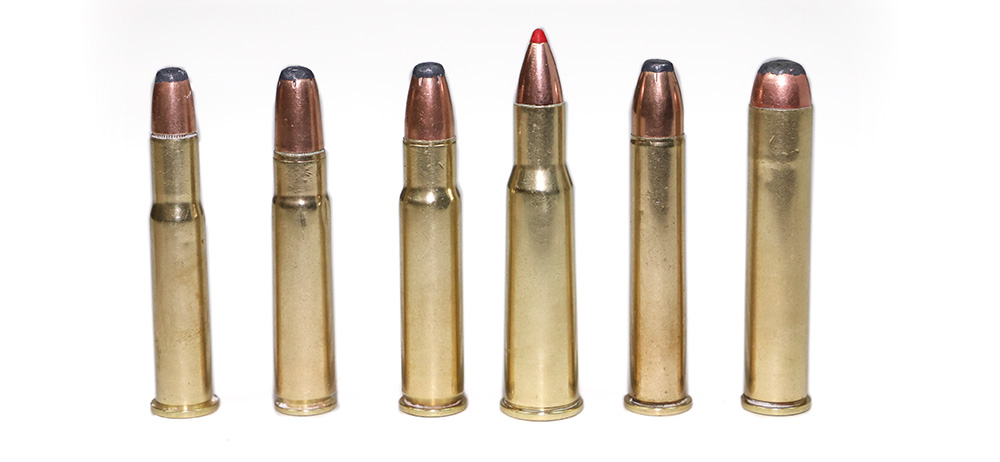
Older brush-busters include (l. to r.): .32 Win. Spl., .35 Rem., .356 Win., .348 Win., .375 Win. and .444 Marlin. All are good hunting cartridges, but they are no longer chambered. Some of these may be resurrected in the future, but certainly not all.
Like the Bushmaster, the .45-70 has too much recoil for youngsters and new shooters. But, as a brush-buster, it has 150 years of impeccable credentials. It and its belted .450 Marlin brother are about the only two of the entire class that could sensibly be used for the largest bears. And, in strong, modern actions, can even be loaded up for Cape buffalo.
At the bottom of the brush-buster scale is .30-30 Win. Still not damning with faint praise; it has long been America’s favorite deer cartridge, and for good reason. By today’s standards, the .30-30 is neither fast nor flashy, but its popular 150-grain load delivers a solid ton of energy. Sure, it doesn’t hold that number for very far, but who cares? If your deer stand offers 100-yard shots, the .30-30 is still all you need. With at least 10 million Marlin and Winchester .30-30 Win. lever-actions out there, it’s not likely they’ll quit loading it. Winchester is still cranking out Model 94s, Henry has numerous variations of its tubular-magazine .30-30 and Ruger has done an awesome job with its Marlin 336. Faithful, accurate and smooth, I got mine too late for last deer season but am planning to hunt whitetails with it this fall.
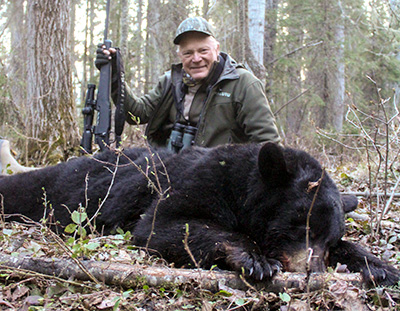
Unlike larger cartridges, the .30-30 Win. doesn’t have greater frontal area, but it does have the advantage of a rich selection of loads, including some that are extra fast. For deer, that doesn’t really matter; all .30-30 loads are good deer medicine. If you’re hunting boars and black bears with your .30-30, and don’t need the range, I’d ignore paper ballistics and use the heavier, blunter 170-grain bullet. It’s slower, with less energy, but it hits harder and penetrates better.
Between .30-30 Win. and .45-70 Gov’t, there are several other classic brush-busters—as effective today as they were yesterday, most with ammunition still loaded (occasionally). The oldest is 1902’s .32 Winchester Special, on paper much like .30-30 but with a .321" bullet versus a .308" one. Its fans swear by it, but I can claim no experience. The 1906 .35 Rem. hits harder, especially with the 200-grain load, is rimless and suitable for a variety of actions. Marlin chambered it almost to the end and Henry has made a few. I’ll bet we’ll see this old-timer again—it’s too good of a cartridge to go away.
Through the 1930s, the lever-action was America’s darling, but bolt-actions were making inroads. Winchester apparently saw the writing on the wall, starting before World War II with faster cartridges intended to revive lever-action sales. First of these was the .348 Win., introduced in 1936 in the Winchester Model 71, the final iteration of John Browning’s 1886 action. The powerful .348 is almost too versatile to be considered a brush-buster, but it was hampered by flat-nosed bullets. At the time, riflescopes were becoming more popular, and the expensive, top-eject Model 71 resisted conventional scope mounting, leading to lackluster sales. The .348 Win. was only chambered in the Model 71, which is not common, but it’s one of my favorites, and Hornady now loads it with a 200-grain FTX spitzer.
In 1955, Winchester replaced the Model 71 with the box-magazined, “scopable” Model 88. One of its original chamberings was the .348’s replacement, the rimless .358 Win., based on a necked-up .308 Win. case. Savage quickly adapted its great Model 99 to .358. By then, the magnum craze had started. Hard-hitting and mild in recoil, the .358 Win. is another great brush-buster, and it’s also a favorite of mine, but it never achieved the popularity it deserved. Browning’s BLR is the last factory rifle offered in .358, and it is also the only current rifle chambered for the .450 Marlin.
Winchester’s efforts to increase lever-action sales weren’t over. In 1978, it introduced the beefed-up Big Bore 94, chambered for .375 Winchester. Essentially an updated and faster version of the old .38-55, the .375 Win. is a fine brush-buster, but it just didn’t take off. In 1982, Winchester tried a final time with the .307 and .356 Win., both based on the .308 case in semi-rimmed versions. Muzzle velocities came close to the .308 and .358 but, as usual, downrange performance was hampered by blunt-nosed bullets.
By this time, riflescopes were in almost universal use. It wasn’t a problem for the side-eject Marlin (or the Savage 99 and Winchester 88), but it was a nightmare for Winchester’s traditional top-eject rifles. Winchester solved this long-standing issue in 1983 with the angle-eject design on its Model 94, finally allowing conventional scope mounting low over the receiver.
Marlin chambered its Model 336 for both .356 Win. and .375 Win., but it also did its own thing. Working with Remington, it lengthened the .44 Mag. case to 2.225", modified the 336 action and introduced the .444 Marlin in 1964. In the strong Marlin action, a 240-grain bullet developed 2,330 f.p.s., yielding almost 3,000 ft.-lbs. of energy. With Ruger churning out high-quality Marlin lever-actions, the .444 could see a revival.
Another cartridge ripe for revival is the .338 Marlin Express. It’s not really a brush-buster, but it’s probably the most versatile cartridge ever housed in a tubular magazine. A joint 2007 Hornady/Marlin project, the .338 Marlin Express was the debut of the FTX bullet, hard-hitting up close, yet offering genuine 300-yard capability. Sadly, it was manufactured only briefly. Maybe Ruger will give it another chance.
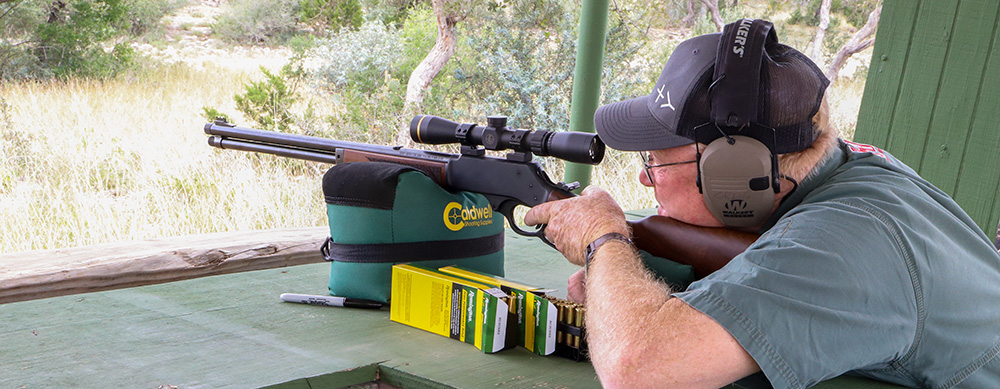
The author on the bench with one of the first Henry rifles chambered for Remington’s 360 Buckhammer. The latest in a long line of .35-cal. brush-busters, one of the new cartridge’s hallmarks is mild recoil with a hard-hitting effect on game.
Carbines chambered for pistol cartridges have been seductive since the .44-40 Win. came along in 1873. Henry currently chambers long guns for the .327 Federal Mag., .357 Mag., .41 Mag. and .44 Mag., plus .44-40 Win. and .45 Colt. As always, velocity and energy increase significantly through longer barrels. All are straight-wall, and some shotgun states have already authorized certain handgun rounds for deer. The .44 Mag. is powerful in handguns, and it really comes alive in carbines. Big Horn Armory (BHA) produces magnificent lever-actions in the big .454 Casull and .460 and .500 S&W cartridges. I have a BHA rifle in .500 and flattened a good-size black bear with it in the spring of 2023. You bet it’s a brush-buster.
I do a lot of hog hunting—a mix of stalking and shooting from stands. I could snipe them from afar, but I enjoy getting close. For me, black bear hunting is the same—except I can’t imagine shooting a bear at some of the distances I read about. It’s safer and more reliable to get in close.
These past few springs, I’ve hunted black bears over bait with the Mack family in northern Alberta. They site their stands unusually close to baits, so any stand can be used for bow or gun—so reach is not needed. With dense, forbidding forest all around, shot placement and performance are what’s important. It’s desirable to hit your bear well and hard, so it goes down on the spot. This won’t always happen, but so far none of my bears have required tracking—thanks to hard-hitting, brush-buster cartridges.





































